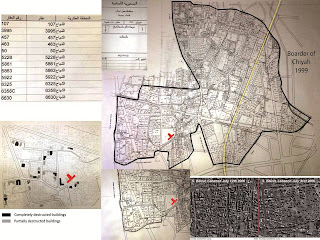Brief History:
Chiyah located in the Southern suburbs of Beirut has always been a refuge for migrants escaping from persecution - Christians seeking refuge throughout the Ottoman reign and Shiites escaping cross-border attacks from Israel. However, throughout history Muslims resided on the western peripheries of the region today called Ghobeiry while Christians towards the East taking the Old Saida road as a strict demarcation line - as the region transformed from a village (agricultural lands) to a city (major industries Ghandour, Red Shoe, Kassardjian etc.), animosity between communities intensified. The region witnessed an exponential growth in the 50's.This abrupt shift and the lack of planning led to complete chaos - there is no rhythm or pattern to the area, no specific typology of neighborhoods and buildings, and people on each side have no clear notion of what's happening on the other side even over 20 years after the end of the civil war.
Area of Interest:
Maroun Misk, a neighborhood in South-West of Chiyah is said to be the only remaining Christian zone on the Muslim side. The neighborhood is calm, with the recently renovated Mar Mekhayel church overlooking three war-torn buildings facing an empty parking lot with two structures dating back to the early 20th century when silk production and agriculture characterized the region. The looming structures narrate the painful history of Chiyah that have been engraved in the collective memory. Opposite Maroun Misk is the new district subject to gentrification, a tabula rasa which the municipality has intentions of transforming to an exclusive high-rise luxury residential towers.
what is my master plan all about?
I wanted to erase the Old Saida Road that has long been a clear barrier, and create a pedestrian axis towards both regions. I rotated the already existing 9m wide tunnel and extended Maroun Misk to the new district. Both areas have always been a detached 'island' since the civil war - I wanted to emphasize this notion of an island yet instead of a no man's land - introduce functions that transform it into a meeting point. A green patch at the gates of Ghobeireh and Chiyah that can be mimicked throughout the former greenline in different empty zones of the area, spreading like a ripple. The masses carrying diverse programs enclose open spaces which will later be defined by the people using the building (fresh market, art center, sports center...) these diverse functions seamlessly interweave through common courtyards or outdoor spaces always keeping people exposed and prone to interact. The Fresh market facing the art center's and the healthcare center's squares, the healthcare center being connected to the gymnasium, which is also connected to the school. The school's playground connected to the community center and the green houses, and the commercial and residential zones. All this intermingling of programs brings together people from diverse backgrounds, neutralizing the animosity between the immediate residents.
With my master plan I'm accepting the reality of the area and using open spaces to define my project to emphasize on transparency. Opening up views to the surroundings. People using my project will constantly be exposed. The massing will be an interplay between inside and outside. My master plan also feeds the deficiencies of the area such as the demand for affordable housing and open spaces, that were boldly expressed by the inhabitants. And other less obvious deficiencies such as the lack of playgrounds at schools, the varying prices of basic foods on opposite sides of the road, complete disrespect to public spaces (throwing garbage out the window of houses), and the refusal of non-residents to enter the neighborhoods of Ghobeiry and Chiyah.
The attempt may seem naive but worth a try. Instilling a sense of responsibility through planting workshops at the community center, near the social housing project, a gymnasium that can be used by schools during recess, sports classes, and competitions. Selling the fresh produce of the greenhouses grown at the community center in the fresh market at reasonably low prices for both parties, and with functions such as the art center inviting non-residents to mingle with the locals.
This new meeting point will not have a clear defined sectarian or political identity.











































